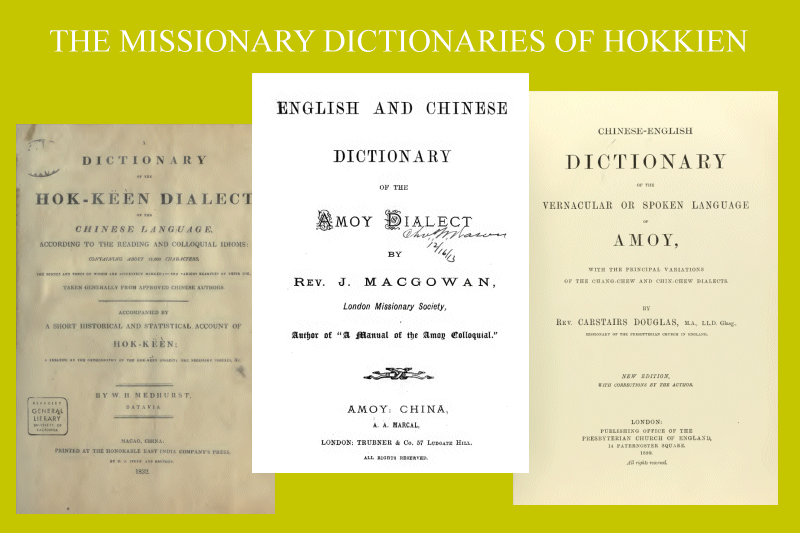
Compiling the Penang Hokkien Dictionary is like retracing the path taken by people who did the same thing long before me. Although I am completely unworthy to stand under their shadows, I have benefited greatly from the work of those 19th missionaries. They gave us dictionaries that have stood the test of time, and are still being referred to right up to this day.
These missionary dictionaries never stop to amaze me, not only with their magnitude, but also with the dedication that these "men of God" invested in order to get their message across. I couldn't find the right words to describe how awed I am that these highly educated people who were so gifted in learning so many languages, could invest the time to compile these dictionaries and still have the time to spread the Gospel. Due to their work, many churches were able to conduct their services in Hokkien (though, to be precise, as most of these dictionaries were compiled in the Amoy dialect, the resulting church services were also conducted in a Hokkien that is really the Amoy dialect).
I looked at what they did, and tried to compare it to what I am doing today, and found that there's just no comparison. I live in an age of computers, word processors and the Internet. If I need to seek a reference material, I google it. If I need someone's input, comment or opinion, I facebook it. And all that I need comes to me without my having to get off my chair.
I tried to imagine the circumstances under which these men worked. No computers, no Internet, no Google, no Facebook. And worst of all, no electricity. I cannot for one moment imagine my world without electricity, and yet these men managed to accomplish what they set out to accomplish using what I regard as the most primitive tools. But their work stand the test of time, and are still being used today, by 21st century learners keen to become literate in Hokkien.
These missionaries must have made countless field trips to interview the native speakers, spoken to them and listened keenly to their diction, ploughed through volumes of old manuscripts, and at some point in time, each of them must have been in custody of whole storehouses filled with stacks of papers, each holding a handwritten entry, with scratched outs, additions, amendments, revisions, all bundled together with hemp strings. I imagine these people, after a long hard day, standing there, looking at what they have compiled, perhaps with a tinge of satisfaction, looking forward to that day when all those handwritten pages would transform into one neat volume.
There are many such dictionaries that are now available online in university websites. I use three of them as my main source of reference. I call them by the name of the missionary who put them together.
Medhurst Dictionary (1832)
The oldest of these dictionaries that I regularly reference is the Medhurst Dictionary (top picture, at left), printed in Batavia (now Jakarta) in 1832. It is credited to Walter Henry Medhurst (1796-1857), an English Congregationalist missionary who did mission work in Malacca, Penang, Batavia and various parts of China.Mr Medhurst's dictionary provides me wonderful glimpses into the romanisation of Hokkien (or as he puts it, Hok-këèn) in used at that early part of the 19th century. Although this dictionary was compiled close to a century before Mandarin was selected to be the sole official language of China, even at that time, Medhurst has already noted the position of Mandarin as a language widely understood across China. I do wonder whether Mr Medhurst could have foreseen the role that Mandarin was to play further down the road.
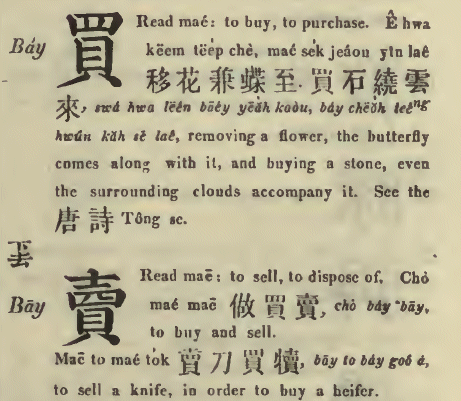
It is interesting to see that Medhurst spelled "to buy", 買, as báy, and "to sell", 賣, as bāy. For me, this is like going full circle, for I re-employ the "ay" digraph for the /e/ finals in my orthography. I do wonder what influenced him to do that.
Unlike the latter missionary dictionaries, Mr Medhurst's dictionary began in 1818 when he was working among the Chinese living in Malacca. You would recall that 1818 is one year before Singapore was founded, and William Farquhar was the Resident of Malacca. Mr Medhurst remarked in his dictionary that the Chinese he came into contact with understood mostly Hokkien, not Mandarin. I could imagine who these people were. If not the Baba Nyonya, they were part of the Wave 2 (which I described in my article on the arrival of the Chinese in the Malay peninsula.)
I do not know whether, at that time, Mr Medhurst had planned to move on to China. But I suppose China must have been in his sight. Nevertheless, he went about his mission work in Malacca, and managed to compile an initial list of Hokkien words which he then got printed in Malacca in 1820.
Singapore was founded a year earlier, and immediately raced ahead of Malacca in significance. The newly established colony has better infrastructure than Malacca, so it was only to be expected that when Medhurst expanded on his word list in 1823, he would send it to Singapore to be published. All this was taking place with the backdrop of the Anglo-Dutch Treaty of 1824, which officially handed Malacca to the British (before that, the British was acting only as caretaker while the Dutch was fending off the French in Europe), in exchange for handing over Bencoolen in Sumatra to the Dutch.
A lack of funds delayed the printing of Medhurst's revised compilation. Like a bride looking for a groom, the manuscript sailed back to Malacca. Then it journeyed up to Penang, only to return once again to Singapore in 1829. During that ding-dong period, Medhurst and a few others continued to improve on their knowledge of Hokkien, and eventually found a publisher in the form of the East India Company in China (EIC) which offered to get the work published for him in Batavia.
The arrival of the EIC into the picture must have influenced the orientation of the work towards becoming "more Chinese". I am only guessing here, but I suppose, had Medhurst found funds to get it published in Malacca, Penang or Singapore, we might today have been privileged to see a lot of Malay loanwords in it. Instead, and perhaps to endear himself to the Select Committee of the EIC, Medhurst added several thousand more Chinese characters. In addition, we are also provided a chapter recounting the history of Fujian Province (or Province of Hok-këèn), which it describes as "one of the smallest yet richest provinces of the Empire".
The Medhurst dictionary was eventually printed by the "Honorable East India Company" at their printing press in Batavia. It is notesworthy that Medhurst was actually two thousand miles from where the printing was place, and he apologized for that, stating, "For any typographical errors, which may creep in during the excution [sic] of the work, the author hopes for the indulgence of the public, as, the work being printed at the distance of nearly two thousand miles from his place of abode, it is impossible for him to correct the sheets as they are put to press, or to mark out any errors which might have inadvertently dropped from his pen in the composition." Once again, Medhurst reminded me that emails have made physical distances immaterial to me, while it was for him very material indeed.
The imminent Robert Morrison, the first Protestant missionary in China, helped to proof read Medhurst's dictionary. As I screened through the dictionary, I observed with some fascination the treatment given to various sounds, such as the nasals. It is also interesting to see how the names of various cities of Fujian Province is spelled in this dictionary. For example, Zhangzhou is spelled Tchang-chew/Chëang-chew) and Xiamen is Emouy/Āy-moôing. I notice that the diacritic marks are already in place, and this was to continue down the century, adopted by later writing systems, such as the Taiwanese Romanisation System, or Tâi-lô.
Douglas Dictionary (1899)
The next important 19th century Hokkien dictionary is the one compiled by Scottish missionary Carstairs Douglas (1830-1877). He lived a very short life, dying at the age of 47 of cholera while still living in Xiamen, and was buried on Gulangyu Island, today a popular Xiamen tourist destination.Unlike Medhurst, Douglas's mission work was confined entirely to China, especially Fujian Province, and particularly Xiamen. It is therefore not surprising that his dictionary encapsulates the vernacular or spoken language of Xiamen, or Amoy as it is then known.
Douglas did justice to the Amoy Dialect by pointing out that the terms "dialect" and "colloquial" may paint the wrong picture of this spoken language. This is after all the language employ by people of all classes, from the well educated right down to the illiterate. Douglas further pointed out that the Amoy Dialect is not a dialect of some other language, it is in fact a distinct language of its own, one of many distinct languages to be found in China.
It was for want of a better name that Douglas and his associates decided to call the language the Amoy Vernacular, and he pointed out that within this Amoy Vernacular are the real dialects, such as the Zhangzhou 漳州, Quanzhou 泉州, Tong'an 同安 and Xiamen 廈門 itself.
According to Douglas, at the time the dictionary was compiled, there were about eight to ten million speakers of "the language of Amoy". I cannot be sure how he came up with that figure. I suppose he totalled up the population of Xiamen, Zhangzhou and Quanzhou. If I do the same thing, the total population of the three prefecture-level cities of Xiamen (2010: 3,531,347)1, Zhangzhou (2010: 4,809,983)2 and Quanzhou (2010: 6,070,617)3 gives us a grand total of 14,411,947. Despite the much higher figure, I fear the number of people who use "the language of Amoy" on a daily basis for their daily interactions can't match that during Douglas's time, not with Mandarin being in the heart of all communications.
To put together his dictionary, Douglas relied on an earlier compilation prepared by another missionary, the late Rev. J. Lloyd. This he found to be useful when he first arrived in Xiamen in 1855. To this, he added more words, from Doty's Manual, and from hiw own collection. Then came the compilation by another missionary, Alexander Stronach, which he also found useful. Although he acknowledges the presence of Medhurst's Dictionary, he did not rely much on it, as he preferred to go to the original source for reference, and I believe he also found Medhurst's work questionable.
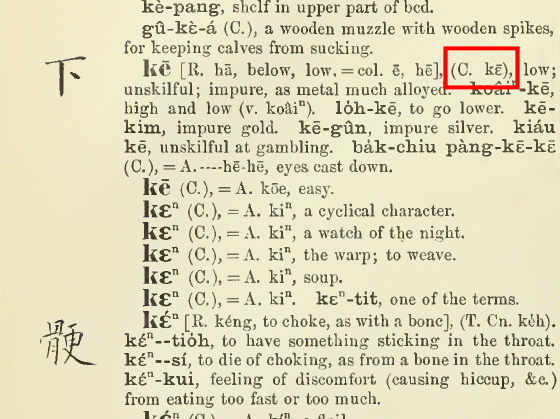
One thing I like about the Douglas Dictionary is that it shows you how words are pronounced outside Xiamen, as in this example, in the Zhangzhou Dialect. As Penang Hokkien derives so much from the Zhangzhou Dialect, such information is invaluable.
An alignment that I found between Douglas and myself is that we both created a dictionary for our own use. In the same way as what Douglas did, I created my Penang Hokkien Dictionary so that I can use it as a reference when I write Penang Hokkien. If as a result, it helps other people, so much the better. But as long as my dictionary enables me to write clearly what I intend to write, it has served and accomplished its purpose.
The initial edition of Douglas's Dictionary was published in 1873. Douglas himself acknowledged a serious defect of that original edition: it is all romanised characters; there were no Chinese characters in it at all. This was because, at the time Douglas and his collaborators completed the manuscript, they have yet to complete identifying the Chinese characters for the words, stating that they have not found the corresponding Chinese character for as many as a quarter or even a third of the words. Also, if he were able to identify those characters, Xiamen did not have the infrastructure for him to do the printing, and he would certainly have to print his dictionary elsewhere, and bring it back to Xiamen.
I am going through the same thing, sort of. I too am seeking out the Chinese characters to add to my still largely romanised dictionary. Often I come across instances where the same word is written using various characters in different dictionaries. At the time I am writing this (Oct 2014), I have only compiled some five thousand plus words in Penang Hokkien, a minute fraction of Douglas's project. I have within my disposal the Internet, Google, Facebook and all the online dictionaries, and yet I found it to be a most painstaking and time-consuming endeavour.
The good news, for Douglas, is that he eventually did manage to get the Chinese characters added to his dictionary, in the second edition, albeit in the form of notes along the margin. Well, better that than nothing.
With the Douglas Dictionary, I can see the Missionary Romanisation (aka Pe̍h-ōe-jī) solidifying into the form that we know today. The ë that you would find in Medhurst's dictionary is absent here. The aspirated consonants, expressed in Medhurst's as p'h, k'h and ch'h, are rendered here as ph, kh and chh. As with Medhurst, the nasal sound is shown with the superscript n, though in the case of the Medhurst, the velar nasal is expressed with the superscript ng, whereas the Douglas does it without a superscript.
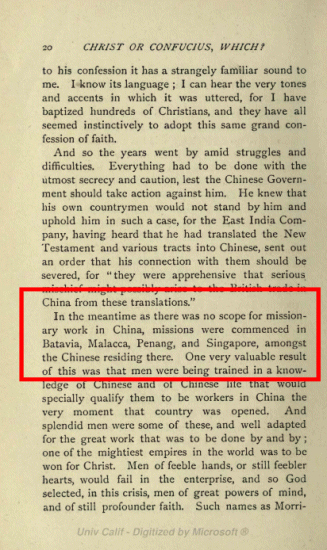
MacGowan said so himself: missions were commenced in Penang et al as there was no scope for missionary work in China.
To be honest I do not find the Medhurst or Douglas dictionaries to be very useful. One reason I found the Douglas dictionary to be not very useful is that the words are arranged in Hokkien (or Amoy) rather than in English. In other words, it is only useful if you are reading something written in the Amoy dialect, and seek out meaning of words you don't understand. It is much harder to look up words in English for their meaning in Amoy Dialect.
Having said that, I like the Douglas dictionary for providing details of whether a specific pronunciation is used in Amoy, Zhangzhou or Quanzhou. It is fascinating to see that the symbol ɛ was already in used in his dictionary, in the formative years of the International Phonetic Alphabet.
MacGowan Dictionary (1883)
The third, and for me, the most useful of the three main missionary dictionaries, is that compiled by Reverend John MacGowan of the London Missionary Society, and published in 1883. Again, as with Douglas, MacGowan did his mission work in Xiamen, and so once again his dictionary also focuses on the Amoy Dialect.In addition to this dictionary, MacGowan also wrote about the Amoy Mission itself, in a separate book entitled Christ or Confucius, Which?, which right from the start mentioned the London Missionary Society's earlier plan to do mission work in Penang as early as 1805, while waiting for a chance to enter China. This did not quite materialize until the later part of the century, through the efforts of Georg Bausum, who laid the foundation for what became the Farquhar Street Mission House and Chapel, precursor to present-day Burmah Road Gospel Hall.
(As I fellowship at Gospel Hall, I could not help feeling that we are the second choice of the missionaries - the Gentile of the Gentile; they only came here, to Penang, because there was no scope for missionary work in China4, but once that came about, those earlier missionaries relocated to China. Nevertheless, thanks to latter missionaries who came after them, the work in Malaya continued, and today, the brethren assemblies are found all over Malaysia and Singapore.)
In terms of orthography and pronunciation, the MacGowan Dictionary bears much similarity to the Douglas. In this dictionary, MacGowan claims that the Amoy dialect (along with its three dialect sisters) is spoken by "at least seven millions of people". Of the four principal dialects, namely the Zhangshou, Quanzhou, Tung'an and Amoy, it has the fewest speakers, and yet it is the most generally understood of them all. This statement, I believe, is due to Xiamen's position at that time, as a political and economic centre of the Hokkien-speaking region in China4.
I must also add that the dictionaries compiled by Douglas and MacGowan further propelled Amoy dialect's position, making it the standard adopted in Taiwan. Until the Ministry of Education in Taiwan developed Tâi-lô and came up with its own dictionary, the romanisation in used in the Douglas and MacGowan dictionaries have been the one favoured by Hokkien speakers, should they wish to write in romanised Hokkien.
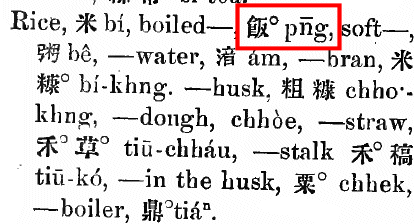
MacGowan shows how the word "rice" is pronounced, in Xiamen dialect, but doesn't mention how the same word is pronounced in Zhangzhou dialect, which happens to be what I want to know. Luckily I got the answer from the Douglas dictionary.
For many, many years, I had an original copy of the MacGowan Dictionary in our family library. I never knew how it got there. It was already there when I was a small boy. But it disappeared when we moved house. I greatly regret that that dictionary is gone, and I don't know where. I wish we (and other members of my family) value it more when it was around, but at that time, we just did not know what to do with it, other than to treat it as an item of curiosity. Being published in 1883, it was also the oldest book in our family library.
I am happy that this dictionary is now digitized and available online (just google to find it). As the MacGowan dictionary is sorted alphabetically in English, it is the most user friendly among the three missionary dictionaries if you wish to look up words in the Amoy dialect. One major drawback of this dictionary (which I cannot entirely blame it) is that it shows only the Amoy dialect. So it ignores pronunciation variation, as with the same word in Zhangzhou or Quanzhou dialect. Unlike the Douglas dictionary, it just doesn't show them. That frustrates my effort in looking for words pronounced the Zhangzhou way, which is often closer to Penang Hokkien than the Xiamen way.Fast Forward to Present Time
For over a century, the orthography established by the missionaries held sway as the way to write Hokkien, if it were romanised (and quite often, unless you want to limit yourself to what Chinese characters are available, you do need the romanised form). During that period, there has been a number of reading material produced in Hokkien, sporadically, some using the missionary romanisation which now became known by its acronym POJ, and some using the author's own way of writing.
On the local front, authors such as Tan Choon Hoe, Raymond Kwok, Johny Chee and Cheah Cheng Seang also produced books in Penang Hokkien. However, all these are phonetic transcription systems - attempts to spell the words based on the author's interpretation of sounds of the words.
Since the 1990s, there has been a surge of interest in Taiwan to develop Taiwanese Hokkien as a native language. Perhaps it is the manifestation of the nationalistic sentiments over there, but whatever it may be, Taiwan has moved ahead of Xiamen as the Hokkien cultural hub5.
In recent years, Taiwan is also the cradle from which the most number of Hokkien writing systems have developed. Apart from POJ, which isn't developed in Taiwan, their homegrown "brand" includes the Taiwanese Language Phonetic Alphabet (TLPA), Modern Literal Taiwanese (MLT), the Daī-ghî tōng-iōng pīng-im (DT), the Taiwanese kana developed when the island was under Japanese rule, and of course, the Taiwanese Romanisation System (Tâi-lô), the one that eventually won out and since 2006 has been the one officially promoted by Taiwan's Ministry of Education.
Why does Taiwan have to develop its own transcription system when there's already the orthography of Missionary Romanisation (POJ)? Well, I would leave Taiwan to answer that question themselves, for I can only answer it for myself. What I can say is that, as long as a place does not have its own homegrown orthography for Hokkien, POJ is the great stand-in. But if it should decide to have its own, then by all means, it should.
I need a homegrown orthography for Penang Hokkien as a means of ensuring its survival, that it does not get swallowed up by other forms of Hokkien, particularly Taiwanese. Looking at POJ, I realise it was created at a time when people do not telecommunicate. As such, there is no issue with creating unique characters, as people who learn the system is expected to handwrite their communication.
In today's world, people telecommunicate extensively using SMS and emails. The existence of diacritic marks and unique letters make POJ difficult to write, often requiring workarounds. As such, the writing system is complex and unattractive to all except the hardcore zealots. Thankfully, the zealots are in the minority. To give Penang Hokkien the best possible chance of survival, I need to have it written in a system that can be rendered using an ASCII standard keyboard, and that is why I created my own writing system. In so doing, I have to turn my back to the writing system that has been in existence for over a century.
I know in the beginning people will not take this new writing system seriously. Many will consider it yet another flash in the pan. It will take time to explain what I am doing, to tell people the difference between an orthography from a transcription, to show them how this new writing system works, and to provide them the reading material in this system. It may be many years before people begin to take notice of Penang Hokkien's homegrown system. For a long while, they will still be reliant on POJ as the means to write Penang Hokkien. But at the same time, they will also notice the growth of reading material that is in this new system, and the only way to make sense of what is written in this new system is to learn it.
As I write this (Oct 2014), I am deeply pleased with the result so far. Although the majority of people are not yet accustomed to writing using the tone numbers, at least they are beginning to understand them when they see them, and they can differentiate the different spellings. All this takes time to sink in, but I see it happening, and I am very deeply satisfied with the progress.
At the same time, my own dictionary has exceeded five thousand entries. This is more than just a word list. In addition to the meaning in English and Malay, I hope to provide the Chinese characters for as many entries as I can find, with example sentences for the majority. This is the only dictionary on the web where you can hear how words in Penang Hokkien are pronounced. Though it takes time to establish itself, I believe in due course it will become a very useful resource for people wanting to know about Penang Hokkien.References
- Wikipedia: https://en.wikipedia.org/wiki/Xiamen
- Wikipedia: https://en.wikipedia.org/wiki/Zhangzhou
- Wikipedia: https://en.wikipedia.org/wiki/Quanzhou
- J. MacGowan: Christ or Confucius, Which? page 20
- Wikipedia: https://en.wikipedia.org/wiki/Hokkien#Standard_Hokkien
Latest updates on Penang Travel Tips
Looking for information on Penang? Use this Map of Roads in Penang to zoom in on information about Penang, brought to you road by road.
Map of Roads in Penang
Disclaimer
Please use the information on this page as guidance only. The author endeavours to update the information on this page from time to time, but regrets any inaccuracies if there be any.
 Copyright © 2003-2025 Timothy Tye. All Rights Reserved.
Copyright © 2003-2025 Timothy Tye. All Rights Reserved.

 Go Back
Go Back